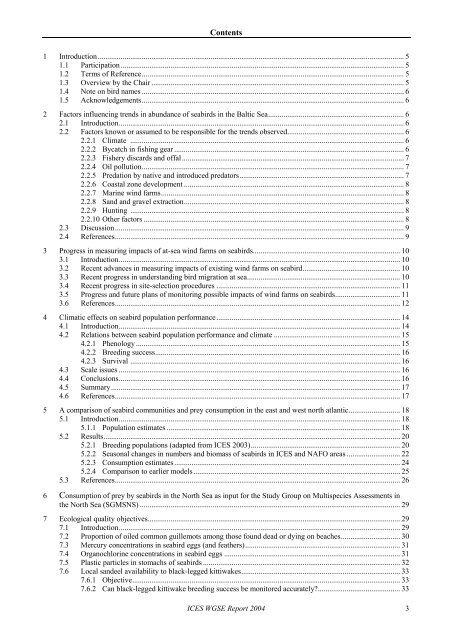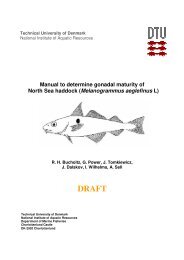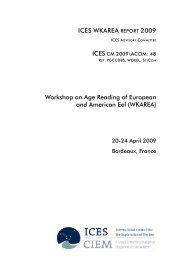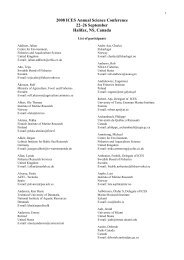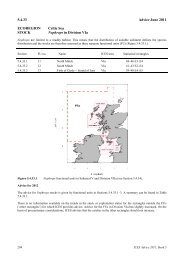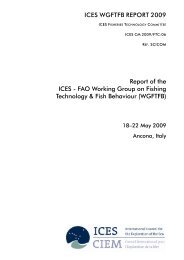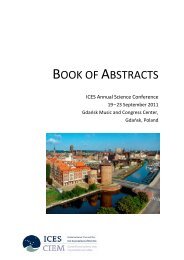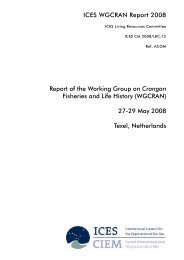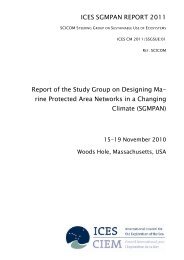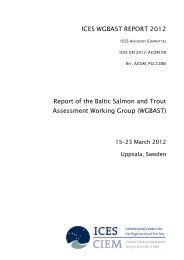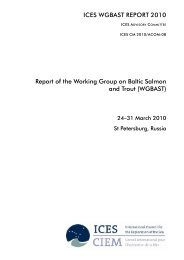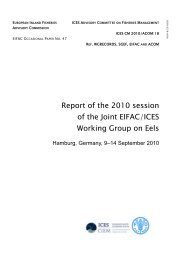Working Group on Seabird Ecology (WGSE). ICES CM 2004/C:05 ...
Working Group on Seabird Ecology (WGSE). ICES CM 2004/C:05 ...
Working Group on Seabird Ecology (WGSE). ICES CM 2004/C:05 ...
- TAGS
- seabird
- ecology
- ices
- www.ices.dk
You also want an ePaper? Increase the reach of your titles
YUMPU automatically turns print PDFs into web optimized ePapers that Google loves.
C<strong>on</strong>tents<br />
1 Introducti<strong>on</strong>................................................................................................................................................................ 5<br />
1.1 Participati<strong>on</strong> .................................................................................................................................................... 5<br />
1.2 Terms of Reference......................................................................................................................................... 5<br />
1.3 Overview by the Chair .................................................................................................................................... 5<br />
1.4 Note <strong>on</strong> bird names ......................................................................................................................................... 6<br />
1.5 Acknowledgements......................................................................................................................................... 6<br />
2 Factors influencing trends in abundance of seabirds in the Baltic Sea....................................................................... 6<br />
2.1 Introducti<strong>on</strong>..................................................................................................................................................... 6<br />
2.2 Factors known or assumed to be resp<strong>on</strong>sible for the trends observed............................................................. 6<br />
2.2.1 Climate ............................................................................................................................................... 6<br />
2.2.2 Bycatch in fishing gear ........................................................................................................................ 6<br />
2.2.3 Fishery discards and offal.................................................................................................................... 7<br />
2.2.4 Oil polluti<strong>on</strong>......................................................................................................................................... 7<br />
2.2.5 Predati<strong>on</strong> by native and introduced predators...................................................................................... 7<br />
2.2.6 Coastal z<strong>on</strong>e development ................................................................................................................... 8<br />
2.2.7 Marine wind farms............................................................................................................................... 8<br />
2.2.8 Sand and gravel extracti<strong>on</strong>................................................................................................................... 8<br />
2.2.9 Hunting ............................................................................................................................................... 8<br />
2.2.10 Other factors ........................................................................................................................................ 8<br />
2.3 Discussi<strong>on</strong>....................................................................................................................................................... 9<br />
2.4 References....................................................................................................................................................... 9<br />
3 Progress in measuring impacts of at-sea wind farms <strong>on</strong> seabirds............................................................................. 10<br />
3.1 Introducti<strong>on</strong>................................................................................................................................................... 10<br />
3.2 Recent advances in measuring impacts of existing wind farms <strong>on</strong> seabird................................................... 10<br />
3.3 Recent progress in understanding bird migrati<strong>on</strong> at sea................................................................................ 10<br />
3.4 Recent progress in site-selecti<strong>on</strong> procedures ................................................................................................ 11<br />
3.5 Progress and future plans of m<strong>on</strong>itoring possible impacts of wind farms <strong>on</strong> seabirds.................................. 11<br />
3.6 References..................................................................................................................................................... 12<br />
4 Climatic effects <strong>on</strong> seabird populati<strong>on</strong> performance................................................................................................ 14<br />
4.1 Introducti<strong>on</strong>................................................................................................................................................... 14<br />
4.2 Relati<strong>on</strong>s between seabird populati<strong>on</strong> performance and climate .................................................................. 15<br />
4.2.1 Phenology .......................................................................................................................................... 15<br />
4.2.2 Breeding success................................................................................................................................ 16<br />
4.2.3 Survival ............................................................................................................................................. 16<br />
4.3 Scale issues ................................................................................................................................................... 16<br />
4.4 C<strong>on</strong>clusi<strong>on</strong>s................................................................................................................................................... 16<br />
4.5 Summary....................................................................................................................................................... 17<br />
4.6 References..................................................................................................................................................... 17<br />
5 A comparis<strong>on</strong> of seabird communities and prey c<strong>on</strong>sumpti<strong>on</strong> in the east and west north atlantic........................... 18<br />
5.1 Introducti<strong>on</strong>................................................................................................................................................... 18<br />
5.1.1 Populati<strong>on</strong> estimates .......................................................................................................................... 18<br />
5.2 Results........................................................................................................................................................... 20<br />
5.2.1 Breeding populati<strong>on</strong>s (adapted from <strong>ICES</strong> 2003).............................................................................. 20<br />
5.2.2 Seas<strong>on</strong>al changes in numbers and biomass of seabirds in <strong>ICES</strong> and NAFO areas ............................ 22<br />
5.2.3 C<strong>on</strong>sumpti<strong>on</strong> estimates...................................................................................................................... 24<br />
5.2.4 Comparis<strong>on</strong> to earlier models............................................................................................................ 25<br />
5.3 References..................................................................................................................................................... 26<br />
6 C<strong>on</strong>sumpti<strong>on</strong> of prey by seabirds in the North Sea as input for the Study <str<strong>on</strong>g>Group</str<strong>on</strong>g> <strong>on</strong> Multispecies Assessments in<br />
the North Sea (SGMSNS) ........................................................................................................................................ 29<br />
7 Ecological quality objectives.................................................................................................................................... 29<br />
7.1 Introducti<strong>on</strong>................................................................................................................................................... 29<br />
7.2 Proporti<strong>on</strong> of oiled comm<strong>on</strong> guillemots am<strong>on</strong>g those found dead or dying <strong>on</strong> beaches............................... 30<br />
7.3 Mercury c<strong>on</strong>centrati<strong>on</strong>s in seabird eggs (and feathers)................................................................................. 31<br />
7.4 Organochlorine c<strong>on</strong>centrati<strong>on</strong>s in seabird eggs ............................................................................................ 31<br />
7.5 Plastic particles in stomachs of seabirds ....................................................................................................... 32<br />
7.6 Local sandeel availability to black-legged kittiwakes................................................................................... 33<br />
7.6.1 Objective............................................................................................................................................ 33<br />
7.6.2 Can black-legged kittiwake breeding success be m<strong>on</strong>itored accurately?........................................... 33<br />
<strong>ICES</strong> <strong>WGSE</strong> Report <strong>2004</strong> 3


